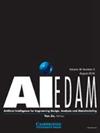ML增强产品的概念设计:用户体验价值框架和CoMLUX设计过程
IF 2.3
3区 工程技术
Q3 COMPUTER SCIENCE, ARTIFICIAL INTELLIGENCE
Ai Edam-Artificial Intelligence for Engineering Design Analysis and Manufacturing
Pub Date : 2023-03-30
DOI:10.1017/S0890060422000270
引用次数: 1
摘要
随着越来越多地利用机器学习(ML)来增强产品的功能,设计研究界开始探索如何支持机器学习增强产品的概念设计。然而,机器学习增强产品的用户体验价值创造仍然具有挑战性,因为机器学习的独特特性和概念设计中的许多复杂因素。为了帮助设计师为ml增强产品创造用户体验价值,我们开发了用户体验价值框架和复杂设计流程。该框架描述了机器学习、利益相关者和上下文如何共同创造机器学习增强产品的用户体验价值,并确定了机器学习的可增长性和不透明性,帮助设计师系统地理解共同创造者,同时避免认知过载。复杂设计过程为设计具有可生长性和透明度的ml增强产品提供了实用指导。最后,我们在一个实际项目中展示了框架和流程的使用方法,并总结了我们工作的启发和局限性。本文章由计算机程序翻译,如有差异,请以英文原文为准。
Towards the conceptual design of ML-enhanced products: the UX value framework and the CoMLUX design process
Abstract With the increasing utilization of machine learning (ML) to enhance products’ capabilities, the design research community has begun to explore how to support the conceptual design of ML-enhanced products. However, UX value creation of ML-enhanced products is still challenging because of ML's unique characteristics and numerous complex factors in conceptual design. To help designers create UX value for ML-enhanced products, we developed the UX value framework and the CoMLUX design process. The proposed framework describes how ML, stakeholders, and context co-create the UX value of ML-enhanced products, and identifies the growability and opacity of ML, helping designers systematically understand the co-creators while avoiding cognitive overload. The CoMLUX design process provides practical guidance for designing ML-enhanced products with growability and transparency. At last, we demonstrate the usage methods of the framework and process in an actual project and summarize the inspirations and limitations of our work.
求助全文
通过发布文献求助,成功后即可免费获取论文全文。
去求助
来源期刊
CiteScore
4.40
自引率
14.30%
发文量
27
审稿时长
>12 weeks
期刊介绍:
The journal publishes original articles about significant AI theory and applications based on the most up-to-date research in all branches and phases of engineering. Suitable topics include: analysis and evaluation; selection; configuration and design; manufacturing and assembly; and concurrent engineering. Specifically, the journal is interested in the use of AI in planning, design, analysis, simulation, qualitative reasoning, spatial reasoning and graphics, manufacturing, assembly, process planning, scheduling, numerical analysis, optimization, distributed systems, multi-agent applications, cooperation, cognitive modeling, learning and creativity. AI EDAM is also interested in original, major applications of state-of-the-art knowledge-based techniques to important engineering problems.

 求助内容:
求助内容: 应助结果提醒方式:
应助结果提醒方式:


